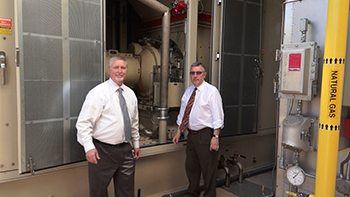Energy Management: A Prescription for your Medical Facility’s Financial Health
 WAYNE, Penn — Hospitals are some of the most energy-intensive buildings in the United States. The EPA estimates that hospitals use more than eight percent of all energy sources and 1.4 percent of the electricity generated in the country spending more than $8 billion on energy each year.
WAYNE, Penn — Hospitals are some of the most energy-intensive buildings in the United States. The EPA estimates that hospitals use more than eight percent of all energy sources and 1.4 percent of the electricity generated in the country spending more than $8 billion on energy each year.
In a typical hospital, lighting, heating and hot water represent between 61 and 79 percent of total energy use depending on climate, making those systems the low-hanging targets for energy savings.
To decrease their energy bills, hospitals have been advised to turn things off and turn things down. But as more hospitals and health care organizations implement conservation and efficiency practices the question arises: How low can you go?
Turning off the lights, more efficient HVAC and medical equipment, green roofs, water conservation and high-efficiency lighting systems all lower energy costs, but they also have a floor as to how low energy costs can be reduced.
Continuous conservation and efficiency improvements are important quick-fix elements in energy cost reduction but are they sufficient to effectively manage a hospital’s long-term energy and profitability strategy? Sure, LED bulbs and more efficient equipment reduce electricity demand, and at a certain price point are smart to install, but the question is how much more energy productive do they really make a medical facility?
The Energy Productivity Lens
What if the premise for your energy management strategy was that efficiency is an engineering ratio, while energy productivity is a management concept? What if the goal was energy productivity to not only reduce energy costs, but also improve energy reliability and your hospital’s long-term financial health? If you viewed energy management from that lens, how would it change your medical facility’s approach?
To measure energy productivity, many facilities operators measure the cost per surface area or square foot. Although I propose that a more meaningful metric is revenue or certainly patient treatment, for the purposes of using an already designated industry measure, we’ll stick with square feet. Let’s say your current or future hospital consumes six watts per square foot, approximately twice as high as the University of Minnesota Sustainable Building Standard. Would you be able to reduce that by half by implementing more efficient HVAC and light bulbs? I would venture to say that you would slice into it pretty good, but most likely not deliver below three watts per square foot. If you were to start with a 1 million-square-foot facility that consumes 6 million watts, or six Megawatts of thermal and electrical energy, lighting would account for approximately 25 percent and HVAC about 28 percent to 30 percent of your total consumption. If you were to improve the efficiency of each system by 20 percent you will have moved the overall productivity from 6 watts per square foot to 5.34 watts per square foot. Good, but not 3 per square foot. On a cost per square footage basis, your savings would be approximately 11 percent.
 Regardless, while one may be successful at reducing overall demand and efficiency, neither your board, stakeholders or bottom line are impressed if inflationary forces or greater demand drive energy unit costs up, negating those gains. Moreover, they will be even less impressed if this is a prescription for contraction or doing less instead of growth and doing more.
Regardless, while one may be successful at reducing overall demand and efficiency, neither your board, stakeholders or bottom line are impressed if inflationary forces or greater demand drive energy unit costs up, negating those gains. Moreover, they will be even less impressed if this is a prescription for contraction or doing less instead of growth and doing more.
What if you could grow your facility’s square feet and still reduce your overall energy bill? One hospital system did just that by focusing on energy productivity: Geisinger Health System.
Based in Danville, Penn., with facilities throughout the state, Geisinger Health System set out to lower the energy bill for its 2.6 million-square-foot main campus in 2010. ZF Energy Development partnered with them and developed a comprehensive energy management plan that included participation in energy markets, the installation of a cogeneration plant, a combustion turbine to make electricity and a waste heat recovery boiler along with a combination of other energy productivity strategies.
While the initial cost of the solution was approximately $5.3 million, the comprehensive energy management program included financial strategies that brought the net cost to only $2.55 million. Exceeding cost-reduction projections by about 15 percent, as of mid-2013, the annual savings on the new system were $2.2 million with a 14-month accelerated payback period. An independent analyst hired by Geisinger confirmed these figures.
During this time, Geisinger added about 500,000 square feet of hospital space and still reduced their energy costs from $3 per square foot to about $1.69 per square foot — a 45 percent reduction — while maintaining five sigma or better uptime reliability.
The success of the Danville plant has led Geisinger to once again partner with ZF Energy Development and implement a similar program in its Wyoming facility, this time including ZF Energy’s Economic Power Dispatcher System, an automated controller that monitors energy costs and leverages marketplace fluctuations.
The Energy Supply Chain
The Geisinger case demonstrates that optimizing cost reductions isn’t an efficiency question, but an energy productivity and management challenge. To more effectively manage your organization’s energy bill you must take a look at and leverage the entire energy supply chain.
A central power plant may produce over 166 times more electricity than a medical facility consumes and has enormous advantages of scale. The grid offers a mix of economically high competitive power resources that can provide electricity at astonishingly low rates. Consider that recently the higher share of wind power, typically peaking production at night, discharges its power onto the grid at negative cost — you are paid to take the power, albeit for short times. Through an efficiency analysis alone, you would never consider the opportunities that the energy supply chain delivers and thus never arrive to net-zero cost.
Reduce Energy Costs and Grow Your Facility
Now that you’re looking at your facility’s metrics from an energy productivity point-of-view, you’ll find bigger opportunities that will have a real impact on your facility’s bottom line and its future while dramatically improving its energy and financial health.
Michael Overturf is CEO of ZF Energy Development. His expertise encompasses a broad spectrum of business and industrial disciplines from information technology and JIT supply chain management, to marketing and energy arbitrage. Synthesizing his in-depth, end-to-end operational knowledge of manufacturing processes, Michael provides strategic counsel on reducing energy costs, managing the implementation of industrial process improvements, bettering system reliability and increasing energy productivity. In addition to his day-to-day activities at ZF Energy Development, Michael is an active speaker, writer and contributor to industry trade publications on the topic of energy, and holds a number of registered energy method patents.
